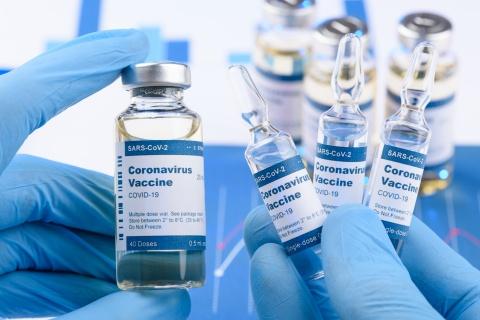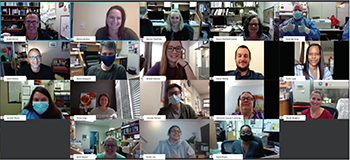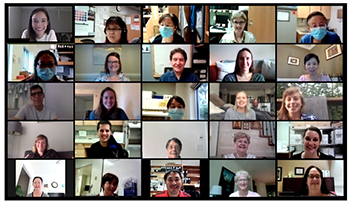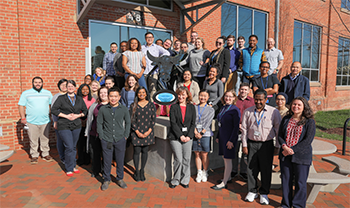
Photo above: SARS-CoV-2 vaccine currently in the testing phase
When the SARS-CoV-2 virus began a global pandemic, lives changed and were left in uncertainty. How can people combat a novel virus? Vaccines provide an answer.
In the Division of Surgical Sciences, Guido Ferrari, MD, David Montefiori, PhD, and Georgia Tomaras, PhD, have researched the connection between antibodies and SARS-CoV-2 in order to create an effective vaccine. This year, they expanded their work from development of an HIV vaccine to include developing one for SARS-CoV-2.

Professor of Surgery, Division of Surgical Sciences
“We’re all interested in identifying the specific immune responses that protect people from infection by the virus,” says Dr. Montefiori. “How the immune system responds to combat SARS-CoV-2 is what we would want a vaccine to do, and we are particularly interested in neutralizing antibodies.”
Different Aspects of Antibodies
The three lab leads are researching different, complementary aspects of antibodies. Dr. Montefiori’s study focuses on neutralization. Dr. Ferrari and Dr. Tomaras study the antibodies in a broader context to see if it is possible that other types of antibody functions would be good to induce with vaccines as well.
Dr. Tomaras’ lab studies the specificity and quality of the antibody that is elicited post vaccination, and whether that corresponds with a protective outcome. In search for answers, Dr. Tomaras’ team evaluates antibody responses that correspond to recovery from a disease.

“We look at the specificity, the strength, of that interaction between the antibody and the epitope on the virus particle, or on the infected cell and then the ability to utilize fragment crystallizable (Fc) region of the antibody,” says Dr. Tomaras. “In particular, my team and I are interested in looking at the strength of binding to Fc receptors and the ability to mediate phagocytosis.”
Dr. Ferrari specifically looks at the component of the antibody that after recognizing infection, can bind to receptors on cytotoxic cells. These cells can either kill the infected cells or work in collaboration with monocytes and neutrophils.

Associate Professor
in Surgery
“Once the antibodies bind the virus, monocytes and neutrophils can capture the complexes called immunocomplexes, and internalize them by phagocytosis to destroy the virus,” says Dr. Ferrari. “The question then is are these phagocytic cells working in a way that will prevent infection, limit infection, and limit the severity of the disease, or will they somehow contribute to the disease themselves. So where do we aim to draw the line to determine how much of a specific type of antibody do we need for the vaccine to work?”
A Significant Development
Dr. Montefiori’s research can potentially answer that question. In studying neutralizing antibodies, he researches mutations that occur in the spike protein of the virus. In collaboration with Dr. Bette Korber from Los Alamos National Laboratory in New Mexico, he noticed a mutation in the spike gene known as D614G.
By looking at the genetic sequences of the spike proteins in a global central sequence database, Dr. Korber’s data suggested that the D614G mutation, or the G form, made the virus more transmissible. The team published this research in Cell.
“There are two forms of the mutation and the D form was becoming less prevalent in the world, while the G form was becoming more prevalent,” says Dr. Montefiori. “That suggested that the G form had an advantage, and our lab work showed that the G form was more infectious, supporting Dr. Korber’s evidence that the virus was more transmissible.”

This was a significant development in Dr. Montefiori’s research, which led to the next question of whether or not the G form of the spike protein mutation was going to be a problem for the vaccines. Dr. Montefiori and his team found that the G form of the virus was not an escape mutation, which would have made the virus less susceptible to the neutralizing antibodies induced by current vaccines. Instead, the G form was actually more sensitive to neutralizing antibodies, meaning that the vaccines might work better against this new form of the virus. With this finding, the team submitted a second paper for review.
“The bottom line is that the vaccines are likely to work better because of this mutation, rather than make it worse,” Says Dr. Montefiori.
Because of this research, Dr. Montefiori was recruited to become a part of Operation Warp Speed, a public–private partnership initiated by the federal government. Their goal is to facilitate and accelerate the development, manufacturing, and distribution of COVID-19 vaccines. As Leader of the Neutralizing Antibody Laboratory Program for phase 3 clinical trials, Dr. Montefiori and his team will be the primary laboratory focusing on neutralizing antibody assays.
The Next Steps
Dr. Montefiori and his team will continue to collaborate with Dr. Korber to keep an eye out for any other mutations in the spike protein that could be a problem for the developing vaccines.

Similarly, Dr. Tomaras and her team are at the point of evaluating the efficacy of the vaccines. Her team will evaluate the antibody responses from those ongoing trials to determine the quality of the antibody in terms of its form.
“We have ideas about what the benchmark for protective antibodies should be, and the evaluation of efficacy in large clinical trials is critical for testing these ideas. The results will give us a guide to what we need for the next round of improvements in a vaccine regimen or they may even give us unexpected insights on how the immune system works to fight viruses,” says Dr. Tomaras.
A Large Village Working Together

The research conducted by Dr. Ferrari, Dr. Montefiori, and Dr. Tomaras has facilitated the discovery of an effective vaccine against SARS-CoV-2. This teamwork offers a fuller picture of how the antibodies fight against the virus.
Collaboration with dedicated Duke scientists has made this research possible. They are conducting critical experiments during the pandemic and have shown how focused and driven they are to getting a vaccine ready for the world.
“The three of us aren’t the only ones researching for a vaccine, but many others from around the world that we work with are as well because each of us can learn from one another on how these antibodies function,” says Dr. Ferrari. “Developing this vaccine is not a one-person show, it takes a large village working together to get there.”
Give to Duke Surgery
A gift to the Department of Surgery is a gift of knowledge, discovery, and life.